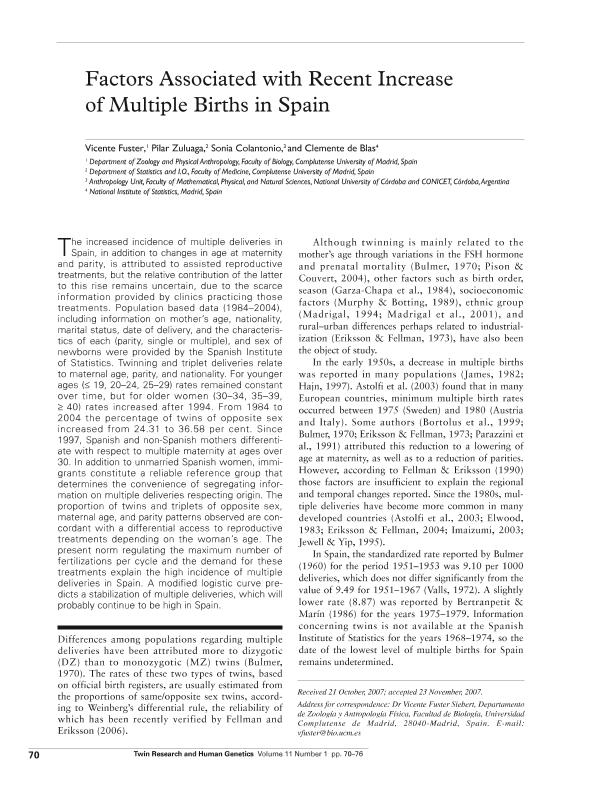Mostrar el registro sencillo del ítem
dc.contributor.author
Fuster Siebert, Vicente
dc.contributor.author
Zuluaga, Pilar
dc.contributor.author
Colantonio, Sonia Edith

dc.contributor.author
De Blas, Clemente
dc.date.available
2021-04-12T11:35:11Z
dc.date.issued
2008-11
dc.identifier.citation
Fuster Siebert, Vicente; Zuluaga, Pilar; Colantonio, Sonia Edith; De Blas, Clemente; Factors associated with recent increase of multiple births in Spain; Australian Acad Press; Twin Research And Human Genetics; 11; 1; 11-2008; 70-76
dc.identifier.issn
1832-4274
dc.identifier.uri
http://hdl.handle.net/11336/129806
dc.description.abstract
The increased incidence of multiple deliveries in Spain, in addition to changes in age at maternity and parity, is attributed to assisted reproductive treatments, but the relative contribution of the latter to this rise remains uncertain, due to the scarce information provided by clinics practicing those treatments. Population based data (1984-2004), including information on mother's age, nationality, marital status, date of delivery, and the characteristics of each (parity, single or multiple), and sex of newborns were provided by the Spanish Institute of Statistics. Twinning and triplet deliveries relate to maternal age, parity, and nationality. For younger ages (≤ 19, 20-24, 25-29) rates remained constant over time, but for older women (30-34, 35-39, ≥ 40) rates increased after 1994. From 1984 to 2004 the percentage of twins of opposite sex increased from 24.31 to 36.58 per cent. Since 1997, Spanish and non-Spanish mothers differentiate with respect to multiple maternity at ages over 30. In addition to unmarried Spanish women, immigrants constitute a reliable reference group that determines the convenience of segregating information on multiple deliveries respecting origin. The proportion of twins and triplets of opposite sex, maternal age, and parity patterns observed are concordant with a differential access to reproductive treatments depending on the woman's age. The present norm regulating the maximum number of fertilizations per cycle and the demand for these treatments explain the high incidence of multiple deliveries in Spain. A modified logistic curve predicts a stabilization of multiple deliveries, which will probably continue to be high in Spain.
dc.format
application/pdf
dc.language.iso
eng
dc.publisher
Australian Acad Press

dc.rights
info:eu-repo/semantics/openAccess
dc.rights.uri
https://creativecommons.org/licenses/by-nc-sa/2.5/ar/
dc.subject
MILTIPLR DELIVERIES
dc.subject
ASSISTED REPRODUCTIVE TREATMENTS
dc.subject
TWINNING AND TRIPLET DELIVERIES
dc.subject
SPAIN
dc.subject.classification
Biología Reproductiva

dc.subject.classification
Ciencias Biológicas

dc.subject.classification
CIENCIAS NATURALES Y EXACTAS

dc.title
Factors associated with recent increase of multiple births in Spain
dc.type
info:eu-repo/semantics/article
dc.type
info:ar-repo/semantics/artículo
dc.type
info:eu-repo/semantics/publishedVersion
dc.date.updated
2021-01-18T15:48:32Z
dc.identifier.eissn
1839-2628
dc.journal.volume
11
dc.journal.number
1
dc.journal.pagination
70-76
dc.journal.pais
Australia

dc.journal.ciudad
Queensland
dc.description.fil
Fil: Fuster Siebert, Vicente. Universidad Complutense de Madrid; España
dc.description.fil
Fil: Zuluaga, Pilar. Universidad Complutense de Madrid; España
dc.description.fil
Fil: Colantonio, Sonia Edith. Consejo Nacional de Investigaciones Científicas y Técnicas. Centro Científico Tecnológico Conicet - Córdoba. Centro de Investigaciones y Estudios sobre Cultura y Sociedad. Universidad Nacional de Córdoba. Centro de Investigaciones y Estudios sobre Cultura y Sociedad; Argentina
dc.description.fil
Fil: De Blas, Clemente. National Institute of Statistics; España
dc.journal.title
Twin Research And Human Genetics

dc.relation.alternativeid
info:eu-repo/semantics/altIdentifier/doi/http://dx.doi.org/10.1375/twin.11.1.70
dc.relation.alternativeid
info:eu-repo/semantics/altIdentifier/url/https://www.cambridge.org/core/journals/twin-research-and-human-genetics/article/factors-associated-with-recent-increase-of-multiple-births-in-spain/DA8E7D4D9ABD4FA7707873D0AAA6FDE1
Archivos asociados
